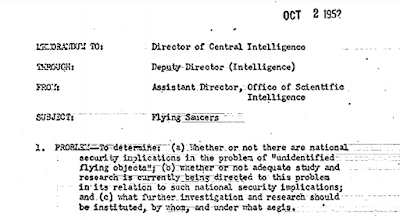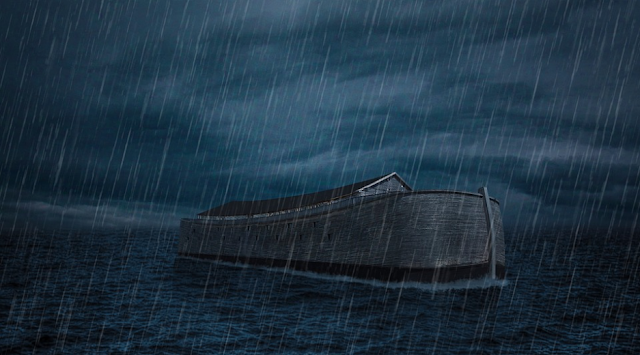The October 1952 Flying Saucers Memorandum is a CIA document compiled on October 02, 1952, regarding whether the effort to research flying saucers was adequate in relation to the possible threat Unidentified Flying Objects (UFOs) posed for the nation in terms of defense and the collective psyche of the population.
What follows is a summary of this memorandum and the corresponding report that was concluded on 24 September 1952.
Memorandum Date: 02 October 1952
Date of Report: 24 September 1952
Date Approved for Release: February 2010
Subject: Flying Saucer Research and Disclosure
The 1952 Flying Saucers Memorandum was composed in October, about a week after its corresponding report had been concluded. It was addressed to Walter B. Smith, Director of the Central Intelligence Agency, and it was sent through the Deputy Director of Intelligence, Loftus E. Becker, from the Assistant Director of the Office of Scientific Intelligence, H. Marshall Chadwell.
The purpose of the report was to determine "whether or not there are national security implications in the problem of unidentified flying objects." The report also served to cite "whether or not adequate study and research is currently being directed to this problem." Finally, it also included a recommendation on what further "investigation and research should be instituted" and by whom.
INADEQUATE UFO INVESTIGATION AND RESEARCH
According to the September 1952 Flying Saucers Report, the Assistant Director of the Office of Scientific Intelligence, H. Marshall Chadwell, concluded that the "Air Technical Intelligence Center, DI, USAF, Wright Patterson Air Force Base, is the only group devoting appreciable effort and study to this subject."
At the time, the Air Technical Intelligence Center (ATIC) was conducting investigations on UFOs on a case-by-case basis, which Chadwell believed was not "adequate to correlate, evaluate, and resolve the situation." Although a worldwide reporting system had been implemented and major Air Force bases had "been ordered to make interceptions of unidentified flying objects," within ATIC, the only staff assigned to this task were "three officers and two secretaries" to which all sighting reports were delivered via official channels.
These men and women were responsible for investigating a massive caseload documented by Chadwell in his report:
"Since 1947, ATIC has received approximately 1500 official reports of sighting plus an enormous volume of letters, phone calls, and press reports. During July 1952 alone, official reports totaled 250. Of the 1500 reports, Air Force carries 20 percent as unexplained and of those received from January through July 1952 it carries 26 percent unexplained."
It was determined that if the purpose of ATIC's investigations were to provide case-by-case explanations for UFO phenomena, the approach was adequate. But that was not the purpose designated to them. The purpose of the ATIC investigation team was to "determine definitively the nature of the various phenomena" which were causing the sightings. They were also tasked with developing a means by which the phenomena and their visual or electronic effects could be identified immediately.
RECOMMENDATIONS FOR UFO INVESTIGATION
In an attempt to form an actionable recommendation regarding the situation, a team from the CIA's Office of Scientific Intelligence researched the efficacy of ATIC's approach to the problem at hand. The team consulted with a representative of the Air Force Special Studies Group. They also discussed the situation with authorities "in charge of the Air Force Project at Wright-Patt Air Force Base." Furthermore, they reviewed a "considerable volume of intelligence reports, checked the Soviet press and broadcast indices, and conferred with three CIA consultants."
Within the report, Chadwell stated that the determination of a CIA consultant was that the solution to this overwhelming problem would only be found either "on the margins or just beyond the frontiers of our present knowledge in the fields of atmospheric, ionospheric, and extraterrestrial phenomena." The consultant also stated that the "dispersal of nuclear waste products might also be a factor."
It was recommended that a team be put together to "analyze and systematize the factors which constitute the fundamental problem." The team should also determine the fields of science pertaining to the phenomena for further investigation, and to make recommendations for the initialization of related research.
Chadwell's report suggested that in accordance with the recommendation by Dr. Julius A. Stratton, Vice President of the Massachusetts Institute of Technology, a group of this nature could be installed within the aforementioned institution and charged to the Air Force's air defense project stationed there, Project Lincoln.
UFO ELEMENTS OF DANGER CITED
Chadwell concluded that "flying saucers posed two elements of danger," both of which had "national security implications." The first element of danger Director Chadwell cited was not national security, it was "mass psychological considerations." This can be better described as mass hysteria, psychological trauma on a national (if not global) scale, and the degradation of instituted social constructs like religion and spiritual beliefs.
According to his analysis of the public's ability to digest the disclosure of extraterrestrial life, Chadwell wrote that the public's efforts to pressure the Air Force into inquiries and reports to the media suggested that "a fair portion of our population is mentally conditioned to the acceptance of the incredible." However, he also stated that the "potential for the touching-off of mass hysteria and panic" was possible.
His recommendation on the disclosure of information was as follows:
"In order to minimize the risk of panic, a rational policy should be established as to what should be told to the public regarding phenomena."
This statement has been discussed to determine whether Chadwell meant that the government should disclose information within the reasonable confines of national security or that a policy of "rational explanations" should be implemented to explain away the phenomena. This has never been determined.
It has long been theorized that if the United States Government was concealing the existence of extraterrestrial life, the central purpose behind this would be the fear of mass hysteria and religious implosion. The latter of these two was held as an integral part of a healthy societal system up to the 21st century when religion ceased in being viewed as the moral compass of a large portion of the U.S. population. The last decade has seen a strong decline in religious adhesion and an increase in personal spiritual beliefs, leading anthropologists to conclude that a large portion of the population no longer finds religion to be the sole factor in morality, but instead personal accountability.
This break in the reliance on strict religious teachings, that often deny the possibility of the existence of intelligent extraterrestrial life, has opened another door for governments to reconsider the limit of disclosure that is possible while preventing mass hysteria.
In the report, Chadwell went on to cite the "vulnerability of the United States to air attack" as the second element of danger and focused on the viability of using the phenomena as part of a "psychological warfare" tactic against the Soviet Union, as well as the Soviet's ability to also do the same. Concern was also applied to the level of Soviet knowledge regarding the phenomena and the "reasons for silence in the Societ press regarding flying saucers."
It had been determined that the Soviets had not published any media reports regarding flying saucers, and it was up for debate on whether that was because they were not experiencing the phenomena, they were causing the phenomena, or state-controlled media required silence on the subject as policy.
Chadwell ended his report by stating:
"I consider this problem to be of such importance that it should be brought to the attention of the National Security Council in order that a community-wide coordinated effort towards its solution may be initiated."
The 1952 Flying Saucers Memorandum can be considered a turning point in the government's ability to invoke plausible deniability. It was one of the first documented instances of a senior official identifying that not enough resources were being allocated to the investigation of flying saucers and citing UFOs as a matter of serious importance, enough to provide recommendations on further research and investigation. The document also highlight's the working mechanisms of government disclosure pertaining to the public and clearly cites instances where an official proves in writing that the United States Government engineers public perception via rational explanations and information suppression.
The October 1952 Flying Saucers Memorandum was sourced via the Freedom of Information Act and can be downloaded via the Central Intelligence Agency webpage.
Related:
CIA Document: Flying Saucers Over Spain and North Africa







